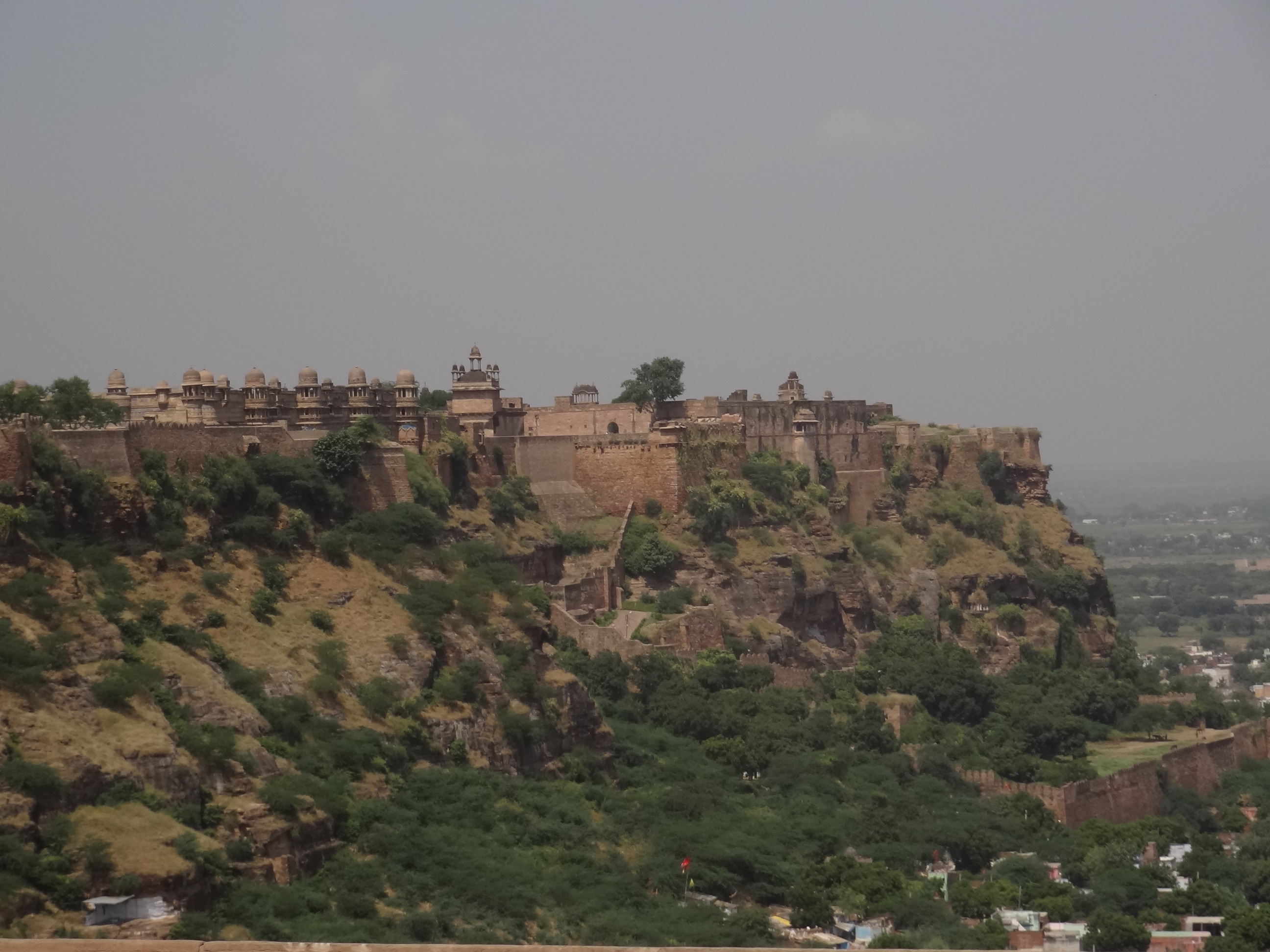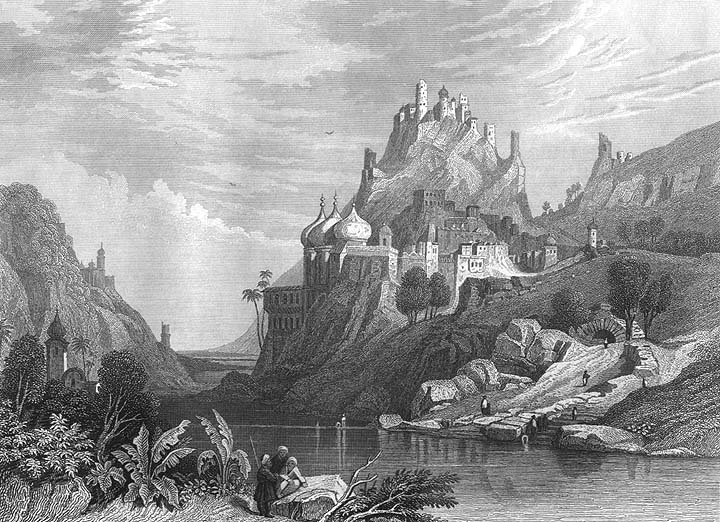|
Tomaras Of Gwalior
The Tomaras of Gwalior (also called Tomar in modern vernaculars because of schwa deletion) were a Rajput dynasty who ruled the Gwalior Fort and its surrounding region in central India during 14th–16th centuries. They are known for their patronage to the cultural activities in Gwalior. The Tomaras originally held a small fief as feudatories of the Tughluq dynasty of Delhi Sultanate. In the 1390s, they gained control of Gwalior, and became independent in the subsequent years. They fought several battles with the Delhi rulers to maintain their independence. Sources of information Much of the information about the Tomaras of Gwalior comes from the Gwalior Fort inscriptions, the contemporary chronicles by Muslim writers, and the various history books on Gwalior (known as ''Guwaliar-nama''s). Two notable ''Guwaliar-nama''s include ''Gopachala-Akhyana'' and ''Qulyat-i-Guwaliari''. The ''Gopachala-Akhyana'' of Khadagrai exists in several different manuscripts. It was written in ... [...More Info...] [...Related Items...] OR: [Wikipedia] [Google] [Baidu] |
Delhi
Delhi, officially the National Capital Territory (NCT) of Delhi, is a city and a union territory of India containing New Delhi, the capital of India. Straddling the Yamuna river, primarily its western or right bank, Delhi shares borders with the state of Uttar Pradesh in the east and with the state of Haryana in the remaining directions. The NCT covers an area of . According to the 2011 census, Delhi's city proper population was over 11 million, while the NCT's population was about 16.8 million. Delhi's urban agglomeration, which includes the satellite cities of Ghaziabad, Faridabad, Gurgaon and Noida in an area known as the National Capital Region (NCR), has an estimated population of over 28 million, making it the largest metropolitan area in India and the second-largest in the world (after Tokyo). The topography of the medieval fort Purana Qila on the banks of the river Yamuna matches the literary description of the citadel Indraprastha in the Sanskrit ... [...More Info...] [...Related Items...] OR: [Wikipedia] [Google] [Baidu] |
Tomara Dynasty
The Tomara dynasty (also called Tomar in modern vernaculars because of schwa deletion) dynasty ruled parts of present-day Delhi and Haryana in India during 8th-12th century. Their rule over this region is attested to by multiple inscriptions and coins. In addition, much of the information about them comes from medieval bardic legends. They belonged to the Tomar clan of the Rajputs. They were displaced by the Chahamanas of Shakambhari in the 12th century, who took over their capital in Delhi, but who were themselves soon displaced by the Ghurid ruler Muhammad of Ghor in 1192 CE. Territory The Tomara territory included parts of the present-day Delhi and Haryana. A 13th century inscription states that the Tomaras ruled the Hariyanaka (Haryana) country before the Chahamanas and the Shakas (Muslims in this context). A 14th century inscription states that they built Dhillika (modern day Delhi) a city in the Haryana region. Around that city is a fortified wall called Lal Kot bui ... [...More Info...] [...Related Items...] OR: [Wikipedia] [Google] [Baidu] |
Ala Ud-din Sikandar Shah
Ala ud-din Sikandar Shah, born Humayun Khan, was the son of Sultan Muhammad Shah Tughluq. He ascended the imperial throne in virtue of his being heir apparent, as Ala-ud-din Sikandar Shah on 1 February 1394 C.E. But after one month and sixteen days he died of natural causes. See also *Delhi Sultanate {{DEFAULTSORT:Sultan Ala-ud-din Sikandar Shah Tughluq sultans ... [...More Info...] [...Related Items...] OR: [Wikipedia] [Google] [Baidu] |
Security Guard
A security guard (also known as a security inspector, security officer, or protective agent) is a person employed by a government or private party to protect the employing party's assets (property, people, equipment, money, etc.) from a variety of hazards (such as criminal activity, waste, damaged property, unsafe worker behavior, etc.) by enforcing preventative measures. Security guards do this by maintaining a high-visibility presence to deter illegal and inappropriate actions, looking (either directly, through patrols, or indirectly, by monitoring alarm, alarm systems or closed-circuit television, video surveillance cameras) for signs of crime or other hazards (such as a fire), taking action to minimize damage (such as warning and escorting trespassers off property), and reporting any incidents to their clients and emergency services (such as the police or paramedics), as appropriate. Security officers are generally uniformed to represent their lawful authority to protect priv ... [...More Info...] [...Related Items...] OR: [Wikipedia] [Google] [Baidu] |
Etawah
Etawah also known as Ishtikapuri is a city on the banks of Yamuna River in the state of Western Uttar Pradesh in India. It is the administrative headquarters of Etawah District. Etawah's population of 256,838 (as per 2011 population census) makes it the one hundred and eightieth-most populous city in India. The city lies southeast of the national capital New Delhi, and northwest of the state capital Lucknow. Etawah is about 120 km east of Agra and is about 140 km west of Kanpur. The city was an important centre for the Indian Rebellion of 1857. It is also the sangam or confluence of the Yamuna and Chambal rivers. It is the 26th most populous city in Uttar Pradesh. Demographics As per the 2011 census, Etawah city had a population of 256,790, of which males were 135,829, and females were 120,961 - an increase of 22% from 211,460 in 2001 census. (The entire Etawah district had a population of 1,581,810 in 2011.) The literacy rate was 82.89 per cent. Hinduism is ... [...More Info...] [...Related Items...] OR: [Wikipedia] [Google] [Baidu] |
Nasir Ud Din Muhammad Shah III
Muhammad Shah was son of Sultan Feroze Shah Tughluq and was ruler of the Muslim Tughlaq dynasty. Life When Sultan Abu Bakr Shah Tughluq became ruler of the Tughlaq dynasty of the Delhi Sultanate, Muhammad Shah as his uncle was opposed to him, and struggled against Abu Bakr over the control of the throne. In August 1390, he launched an attack on Delhi and battled Abu Bakr Shah, Abu Bakr Khan for the throne of Delhi. Eventually Abu Bakr was defeated, and Muhammad Shah succeeded him as king, reigning from 1390 to 1394. After Abu Bakr's defeat, Muhammad Shah imprisoned him in the fort of Meerut where he died soon after. Muhammad Shah ruled the Delhi Sultanate for four years before his death on 20 January 1394. References See also * Delhi Sultanate {{DEFAULTSORT:Sultan Muhammad Shah Tughluq 03 Tughluq sultans 14th-century Indian Muslims 14th-century Indian monarchs ... [...More Info...] [...Related Items...] OR: [Wikipedia] [Google] [Baidu] |
Yahya Bin Ahmad Sirhindi
Yahya bin Ahmad Sirhindi (nisba of Sirhind) was a 15th century Indian chronicler who wrote ''Tarikh-i-Mubarak Shahi'', a Persian language chronicle of the Delhi Sultanate. Written during the reign of Mubarak Shah, his work is an important source of information for the Sayyid dynasty. ''Tarikh-i-Mubarak Shahi'' Yahya expected to become a courtier of Mubarak Shah (r. 1431-1434), a ruler of the Delhi Sultanate. Therefore, he wrote ''Tarikh-i-Mubarak Shahi'' and presented it to the Sultan, hoping to win the royal patronage. The book begins with the conquests of Muhammad of Ghor (1149-1206), and ends abruptly in 1434. Several earlier royal chroniclers had written texts describing the 13th-15th century history of the Delhi Sultanate. For example, Minhaj-i-Siraj covered the period up to 1259 in his ''Tabaqat-i Nasiri'', Ziauddin Barani covered 1259-1356, and Shams-i Siraj Afif covered 1356-1388. Yahya carried forward this chronology all the way to 1434. For the events up to 1351, ... [...More Info...] [...Related Items...] OR: [Wikipedia] [Google] [Baidu] |
Gird, India
Gird (also known as Gopasetra in ancient times, or Gwalior region later) is a region of the Madhya Pradesh state in central India. It includes the districts of Bhind, Gwalior, Morena, Sheopur, and Shivpuri. Gwalior is the largest city in the region, and its historic center. The Chambal and Yamuna rivers form the northwestern and northern boundaries of the region. Hadoti region of Rajasthan lies to the southwest, Malwa region of Madhya Pradesh lies to the south, Bundelkhand region of Madhya Pradesh and Uttar Pradesh lies to the east and Braj region of Uttar Pradesh lies to the North. Geography The region is semi-arid characterized by black less fertile soil, rainfall of 200 to 300 mm/year, and winter temperatures that sometimes drop below 5 degrees Celsius. Major crops in the region include soya bean, gram, and wheat and under-assured irrigation, and guava, ber, aonla, and custardapple. History ''See: Gwalior state Gwalior state was a semi-autonomous Maratha st ... [...More Info...] [...Related Items...] OR: [Wikipedia] [Google] [Baidu] |
Parihar
Pratihar, Padiyar is a Rajput Rajput (from Sanskrit ''raja-putra'' 'son of a king') is a large multi-component cluster of castes, kin bodies, and local groups, sharing social status and ideology of genealogical descent originating from the Indian subcontinent. The term Ra ... clan. References Rajput clans {{more categories, date=September 2021 ... [...More Info...] [...Related Items...] OR: [Wikipedia] [Google] [Baidu] |
Muhammad Bin Tughluq
Muhammad bin Tughluq (1290 – 20 March 1351) was the eighteenth Sultan of Delhi. He reigned from February 1325 until his death in 1351. The sultan was the eldest son of Ghiyath al-Din Tughluq, founder of the Tughlaq dynasty. In 1321, the young Muhammad was sent by his father to the Deccan Plateau to fight a military campaign against the Kakatiya dynasty. In 1323, the future sultan successfully laid siege upon the Kakatiya capital in Warangal. This victory over King Prataparudra ended the Kakatiya dynasty. Muhammad ascended to the Delhi throne upon his father's death in 1325. Accounts by visitors of the Sultan Muhammad n describe him as an "inhuman eccentric" with bizarre character. The sultan is said to have ordered the massacre of all the inhabitants of the Hindu city of Kannauj. He is also known for his wild policy swings. Muhammad bin Tughluq had an interest in medicine. He was also skilled in several languages: Persian, Hindavi, Arabic, Sanskrit and Turkish. Ibn Batt ... [...More Info...] [...Related Items...] OR: [Wikipedia] [Google] [Baidu] |
Anangpal Tomar
Anangpal II, popularly known as Anangpal Tomar, was a ruler from the Tomar Rajput dyansty. He is known to have established and populated Delhi in the 11th century. He is often confused with Anangpal I, the founder of Tomar Dynasty of Delhi, who had reigned during the 8th century. He traced the lineage to Chandravanshi Kshatriya kings, namely Arjuna from the epic Mahabharata (nowadays commonly referred to as Tomar/Tanwar). Ancestry According to legend Tomar were descendant of kuru king Parikshit. Territory The territory ruled by the Tomars was called ''Hariyana'' (literally 'Abode of God'). This ''Hariyana'' was many folds in size compared to the current state of Haryana. The Tomar Empire during the reign of Anangpal II extended over various parts of Delhi, Haryana, Punjab, Himachal Pradesh, Uttar Pradesh, Madhya Pradesh and Rajasthan. The capital of Tomars changed a few times during the course of 457 years they ruled in the northern India. The first capital of the To ... [...More Info...] [...Related Items...] OR: [Wikipedia] [Google] [Baidu] |
Janamejaya II
Janamejaya ( sa, जनमेजय) was a Kuru king who reigned during the Middle Vedic period. Along with his father and predecessor Parikshit, he played a decisive role in the consolidation of the Kuru state, the arrangement of Vedic hymns into collections, and the development of the orthodox srauta ritual, transforming the Kuru realm into the dominant political and cultural part of northern India. He also appears as a figure in later legends and traditions, the Mahabharata and the Puranas. Etymology The name ''Janamejaya'' means "man-impelling". In Vedic Literature The '' Aitareya Brāhmaṇa'' states that he was a great conqueror and that his '' purohita'' (domestic priest) Tura Kāvaṣeya consencrated him as king and officiated his '' aśvamedha'' (horse sacrifice). It also states that at one of his sacrifices he did not employ the Kaśyapas as priests but rather the Bhūtavīras. It states that the Asitamr̥ga family of Kaśyapas were eventually reemployed by Janame ... [...More Info...] [...Related Items...] OR: [Wikipedia] [Google] [Baidu] |


.png)


.jpg)
.png)